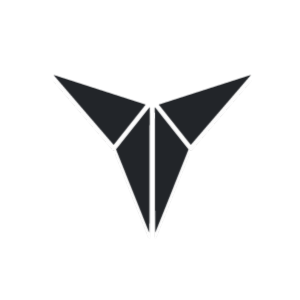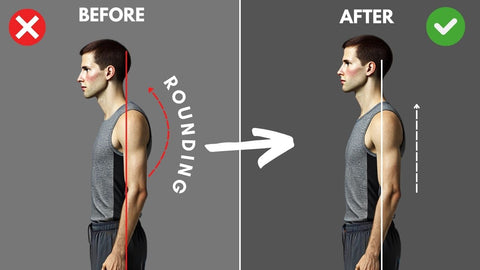Why Your Head Keeps Pushing Forward
You correct your neck position. But hours later, your head is forward again.
Maybe you've tried neck stretches, chin tucks, or posture reminders. You've strengthened your neck. Adjusted your monitor height. Every video promises a fix, but nothing lasts.
By the end of the day, your head is jutting forward again. Your neck aches. Your upper back burns. And no matter how often you pull your head back, it feels like your body is stuck in this forward pattern.
If this sounds familiar, you're not alone.
Your Feet Control Your Head Position
Your brain receives faulty position signals from your feet and makes your entire body adjust upward to keep you from falling over. The result? Your head ends up 2-3 inches forward of where it should be, creating rounded shoulders and chronic neck tension that no amount of stretching can fix.
FIX MY FORWARD HEAD POSTUREMost people think forward head posture is just about weak neck muscles or bad habits. So they keep doing the same exercises. But the truth is, if your head keeps pushing forward no matter what you do, the root cause might be hidden somewhere completely different.
What if it's not about the neck muscles at all… but about how your brain controls your entire postural chain?
In this guide, we'll show you why three simple exercises work when nothing else has and why real posture correction starts with nervous system retraining, not more neck strengthening.
If you're tired of chasing the same symptoms, this might finally connect the dots.

Understanding Neck Anatomy
Now that we've addressed the frustration—the endless cycle of correcting and re-correcting your head position—it's time to look at what's really happening.
Your neck isn't just a simple stack of bones. It's a complex system of vertebrae, muscles, and neural pathways that must coordinate perfectly to hold your 10-12 pound head in proper alignment.
At the core of neck function are the cervical vertebrae—seven small bones that support your head while allowing incredible mobility. But here's what most people don't understand: these vertebrae depend entirely on muscle control for stability.
The key muscles involved include:
Deep neck flexors: Small muscles at the front of your neck that pull your head back into alignment.
Suboccipitals: Tiny muscles at the base of your skull that fine-tune head position.
Upper trapezius: Often overworked when compensating for forward head posture.
Levator scapulae: Connects your neck to your shoulder blade and gets chronically tight.

But here's the problem: most rehab protocols focus only on strengthening these muscles.
What they miss is that forward head posture is rarely just a neck problem. It's a whole-body compensation pattern that starts from your feet and travels up through your pelvis, spine, and into your neck.
When your foundation is off—whether from poor foot mechanics, pelvic tilt, or sensory dysfunction—your head shifts forward to maintain balance. This throws off the entire cervical spine, leading to compression, pain, and that stubborn forward position.
So if you've been doing neck exercises but your head keeps pushing forward, your neck isn't the root problem.
What's Really Driving Forward Head Posture? The Nervous System Connection
It's easy to blame screens or desk work. Yes, looking down all day trains your head into a forward position. But that's only part of the picture.
What's rarely talked about is how the brain adapts to that forward position and starts reinforcing it as the "new normal."
Here's what happens:
When your head moves forward, your entire nervous system recalibrates. The muscles that should hold your head back get inhibited. Your brain—always trying to conserve energy—locks this faulty pattern as your default.
Over time, the deep neck flexors that pull your head back get weaker. The posterior neck muscles stay chronically tight. Your upper traps work overtime. This is where neck pain, headaches, and that burning between your shoulder blades come from.
So fixing forward head posture isn't about constantly pulling your head back or doing more neck strengthening. It's about resetting the nervous system patterns that keep pushing your head forward.

As you can see in the picture on the left, the head is positioned far forward of the shoulder line. After working on proprioception and nervous system retraining, you can see in the picture on the right that the head has returned to proper alignment over the shoulders.
Now that you understand the deeper cause, let's move into the 3 exercises that actually start fixing it from the ground up.
Note that these exercises focus on control and precision rather than strength. You'll be surprised how challenging proper form can be even without any resistance.
Three Exercises to Fix Forward Head Posture Permanently
Important: These exercises help retrain head position, but without correcting your foot mechanics first, your head will keep drifting forward because your brain is still receiving faulty balance signals from your feet.That's why we recommend starting with Therapeutic Insoles while you practice these movements.
1. Chin Tucks

Here's how to do it:
- Stand with your back against a wall, feet slightly forward
- Gently draw your chin straight back (not down) as if making a double chin
- Keep your eyes level - don't look up or down
- Hold for 5 seconds, feeling the stretch at the base of your skull
- Perform 10-15 repetitions, 3-4 times per day
Safety Note:
This should feel like a gentle stretch, not painful. If you experience dizziness or sharp pain, reduce the intensity or consult a healthcare provider.
2. Neck Stretches

Here's how to do it:
- Sit or stand with good posture
- Slowly turn your head to the right until you feel a gentle stretch
- Hold for 15-20 seconds
- Return to center and repeat on the left side
- Next, slowly tilt your ear toward your shoulder on each side
- Perform 3-5 repetitions in each direction
Safety Note:
Move slowly and never force the stretch. Stop if you experience any tingling or numbness in your arms.
3. Upper Trap Stretch

Here's how to do it:
- Sit on a chair and hold the seat with one hand
- Tilt your head away from that side, bringing your ear toward the opposite shoulder
- Use your other hand to gently increase the stretch by placing it on your head
- Hold for 20-30 seconds
- You should feel the stretch from your neck down into your shoulder
- Repeat 2-3 times on each side
Safety Note:
Apply gentle pressure only. The stretch should be comfortable, not painful. If you have any neck injuries, consult a healthcare provider first.
Progressive Training Schedule
Week 1-2: Focus on mastering chin tuck form with 3 sets daily
Week 3-4: Add neck stretches and upper trap stretches to your routine
Month 2+: Maintain all three exercises daily while monitoring head position improvements
For a complete posture correction program that addresses all aspects of alignment, explore our comprehensive training programs.
Watch: Complete Forward Head Posture Tutorial
This comprehensive video demonstrates all three exercises covered in this guide. Watch along to see proper form, common mistakes to avoid, and safety tips.
Video Summary: Learn step-by-step instructions for chin tucks, neck stretches, and upper trap releases with proper form demonstration.
Transform Your Posture and Correct Forward Head Position
Struggling with forward head posture, neck pain, or tech neck? The solution starts with your feet. Poor foot mechanics create imbalances that travel up the body, forcing your head forward to maintain balance.
Our Therapeutic Insoles activate your midfoot and realign posture from the ground up.
By correcting your foundation, you can:
- Reverse forward head posture and reset your alignment
- Release chronic neck tension and upper back pain
- Stand, walk, and sit with natural head positioning
When to Expect Results
Most people notice immediate improvements in neck awareness when they begin chin tucks consistently. The neurological benefits of proper head positioning start working within the first week of practice.
Structural changes in neck alignment typically become noticeable after 2-3 weeks of consistent training. The key is understanding that you're retraining nervous system patterns that have been ingrained over years, which takes patience but creates lasting transformation when done correctly.
Frequently Asked Questions About How to Fix Forward Head Posture
What causes forward head posture?
Forward head posture is a nervous system dysfunction where your brain receives faulty signals from your feet, eyes, and jaw. Your brain locks your head forward as a protective response to these mixed signals.
What are the best exercises to fix forward head posture permanently?
The most effective approach combines chin tucks, neck stretches, and upper trap releases with nervous system retraining through proper foot stimulation. Traditional neck exercises alone won't create lasting change without addressing the nervous system first.
How long does it take to fix forward head posture?
When addressing the nervous system dysfunction, changes can begin immediately. Complete nervous system retraining typically takes 4-8 weeks of consistent practice.
Can poor foot alignment contribute to forward head posture?
Yes - your feet contain over 200,000 sensory receptors that tell your brain where you are in space. When these sensors send confused signals, your brain shifts your head forward to maintain balance.
How can I prevent forward head posture and maintain correct neck alignment?
Prevention requires clear communication between your sensory systems and brain through therapeutic insoles for foot sensors, regular screen breaks with eye exercises, and daily chin tucks. When these sensory inputs stay clear, your head position maintains itself automatically.
Next up: Looking for more ways to improve your posture? Check out these related guides:
Conclusion
Fixing forward head posture isn't about doing more neck exercises—it's about addressing the neurological patterns that keep pushing your head forward. These three exercises target the key areas for neck realignment, but remember that lasting change requires addressing your body's foundation.
When you combine targeted neck exercises with proper postural support through therapeutic insoles, you create a comprehensive approach that addresses both the symptoms and the underlying cause of forward head posture.
Start implementing these exercises consistently, and consider how your body's foundation might be contributing to your postural challenges. Your neck—and your entire body—will thank you for taking this holistic approach.
References:
- Day, B. L., Steiger, M. J., Thompson, P. D., & Marsden, C. D. (1993). Effect of vision and stance width on human body motion when standing: Implications for afferent control of lateral sway. The Journal of Physiology, 469(1), 479-499.
- Kavounoudias, A., Roll, R., & Roll, J. P. (2001). Foot sole and ankle muscle inputs contribute jointly to human erect posture regulation. The Journal of Physiology, 532(3), 869-878.
- Oyarzo, C. A., Villagrán, C. R., Silvestre, R. E., Carpintero, P., & Berral, F. J. (2014). Postural control and low back pain in elite athletes comparison of static balance in elite athletes with and without low back pain. Journal of Back and Musculoskeletal Rehabilitation, 27(2), 141-146.
- Shaikh, A. G., & Zee, D. S. (2017). Eye Movement Research in the Twenty-First Century—a Window to the Brain, Mind, and More. The Cerebellum, 17(3), 252-258.
- Wang, Z., & Newell, K. M. (2012). Asymmetry of foot position and weight distribution channels the inter-leg coordination dynamics of standing. Experimental Brain Research, 222(4), 333-344.




